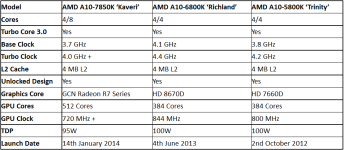So AMD would really need to consider a Triple or Quad Channel memory controller come the DD4 Kaveri refresh if they want to unleash it's full potential
These are not performance parts!
They are for entry level systems and not designed to compete with discrete gfx cards.
AMD are not going to throw money into elaborate memory controller designs for the segment of the market these SKU's are designed for.






